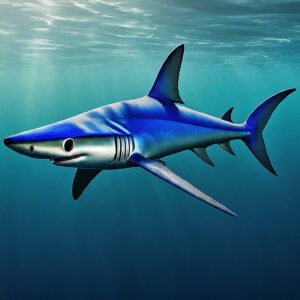
The United States is home to a diverse coastline along both the Atlantic and Pacific Oceans, as well as the Gulf of Mexico. As a result, various shark species inhabit the waters off U.S. beaches. This comprehensive article provides an overview of the sharks commonly found along U.S. shores, their behaviors, safety considerations, and conservation efforts.
Common Shark Species Along U.S. Beaches
Atlantic Coast:
- Blacktip Shark (Carcharhinus limbatus):
- Characteristics: Recognizable by black-tipped fins, often found in nearshore waters.
- Behavior: Known for leaping out of the water, especially during feeding.
- Spinner Shark (Carcharhinus brevipinna):
- Characteristics: Distinguished by its spinning leaps, found in warm coastal waters.
- Behavior: Agile and acrobatic, known for spinning in the air.
- Bull Shark (Carcharhinus leucas):
- Characteristics: Robust and aggressive, able to tolerate freshwater, often found in estuaries.
- Behavior: Known for its adaptability to various environments, including brackish and freshwater.
- Sandbar Shark (Carcharhinus plumbeus):
- Characteristics: Large coastal shark with a high first dorsal fin.
- Behavior: Often found in shallow coastal waters, occasionally forming large aggregations.
Pacific Coast:
- Great White Shark (Carcharodon carcharias):
- Characteristics: Large and powerful, known for its prominent white coloration.
- Behavior: Apex predator, found near seal colonies, known for breaching while hunting.
- Thresher Shark (Alopias spp.):
- Characteristics: Elongated tail, distinctive long upper lobe.
- Behavior: Known for using its long tail to stun prey, often found in deep waters.
- Mako Shark (Isurus spp.):
- Characteristics: Streamlined body, known for high speeds and jumps.
- Behavior: Fastest shark species, often found in open ocean and coastal areas.
Gulf of Mexico:
- Hammerhead Shark (Sphyrna spp.):
- Characteristics: Unique hammer-shaped head with eyes on the sides.
- Behavior: Often found near the Gulf coast, with various hammerhead species.
- Tiger Shark (Galeocerdo cuvier):
- Characteristics: Large and robust, recognizable by dark vertical stripes.
- Behavior: Known for a broad diet, including turtles and marine mammals.
Folly Beach, SC:
- Leopard Shark (Triakis semifasciata):
- Characteristics: Recognizable by its distinctive leopard-like pattern.
- Behavior: Prefers shallow waters, often found near the shore. Not known for aggressive behavior.
- Blacktip Shark (Carcharhinus limbatus):
- Characteristics: Black-tipped fins and streamlined body.
- Behavior: Frequently seen close to shore, known for leaping out of the water.
- Spinner Shark (Carcharhinus brevipinna):
- Characteristics: Known for spinning leaps and slender body.
- Behavior: Agile and acrobatic, often seen in warm coastal waters.
San Francisco Bay, CA:
- Sevengill Shark (Notorynchus cepedianus):
- Characteristics: Distinguished by seven gill slits, robust body.
- Behavior: Nocturnal feeder, often found in deep waters, known for scavenging.
- Leopard Shark (Triakis semifasciata):
- Characteristics: Leopard-like pattern, relatively small in size.
- Behavior: Common in shallow coastal waters, including estuaries.
Topsail Beach, NC:
- Blacktip Shark (Carcharhinus limbatus):
- Characteristics: Black-tipped fins and streamlined body.
- Behavior: Often found close to the shore, known for its leaping behavior.
- Sandbar Shark (Carcharhinus plumbeus):
- Characteristics: Large coastal shark with a high first dorsal fin.
- Behavior: Prefers shallow coastal waters, occasionally forms large groups.
Waikiki Beach, HI:
- Tiger Shark (Galeocerdo cuvier):
- Characteristics: Large and robust, recognizable by dark vertical stripes.
- Behavior: Apex predator, known for a broad diet, including turtles.
- Galapagos Shark (Carcharhinus galapagensis):
- Characteristics: Grey with a slender body and distinctive dorsal fin.
- Behavior: Typically found in deeper waters, near islands and seamounts.
Bora Bora:
- Blacktip Reef Shark (Carcharhinus melanopterus):
- Characteristics: Black-tipped fins and slender body.
- Behavior: Often found in shallow, clear waters around coral reefs.
- Lemon Shark (Negaprion brevirostris):
- Characteristics: Pale yellow-brown coloration, robust body.
- Behavior: Common in warm coastal waters, including lagoons.
Corfu, Greece:
- Blue Shark (Prionace glauca):
- Characteristics: Sleek, deep blue coloration.
- Behavior: Prefers open ocean, known for long-distance migrations.
- Shortfin Mako Shark (Isurus oxyrinchus):
- Characteristics: Fastest shark species, streamlined body.
- Behavior: Often found in open ocean, known for high-speed pursuits.
Destin, FL:
- Bull Shark (Carcharhinus leucas):
- Characteristics: Robust and aggressive, able to tolerate freshwater.
- Behavior: Often found in estuaries and nearshore waters.
- Hammerhead Shark (Sphyrna spp.):
- Characteristics: Unique hammer-shaped head with eyes on the sides.
- Behavior: Various hammerhead species may be present near the Gulf coast.
Kauai, HI:
- Galapagos Shark (Carcharhinus galapagensis):
- Characteristics: Grey with a slender body and distinctive dorsal fin.
- Behavior: Typically found in deeper waters, near islands and seamounts.
- Tiger Shark (Galeocerdo cuvier):
- Characteristics: Large and robust, recognizable by dark vertical stripes.
- Behavior: Apex predator, known for a broad diet, including turtles.
Lake Tahoe:
Lake Tahoe is a freshwater lake, and traditional sharks do not inhabit freshwater environments. However, it may have non-threatening fish species.
Nassau, Bahamas:
- Caribbean Reef Shark (Carcharhinus perezi):
- Characteristics: Grey with a white underside, streamlined body.
- Behavior: Common in the Caribbean, often found near coral reefs.
- Nurse Shark (Ginglymostoma cirratum):
- Characteristics: Eel-like appearance, barbels on the snout.
- Behavior: Bottom-dweller, often seen resting on the ocean floor.
Factors Influencing Shark Presence
a. Environmental Conditions:
- Temperature: Sharks are cold-blooded and are influenced by water temperatures.
- Salinity: The varying salinity levels in coastal areas can attract different shark species.
b. Seasonal Patterns:
- Migration: Some shark species follow seasonal migration patterns along the coasts.
c. Prey Availability:
- Abundant Food Sources: Areas with rich marine life attract sharks in search of prey.
d. Human Activities:
- Fishing and Discards: Fishing activities can attract sharks, as they scavenge on discarded fish.
Safety Considerations
a. Public Awareness:
- Education Programs: Public awareness initiatives inform beachgoers about shark behavior and safety measures.
- Signage and Alerts: Clear signage and alerts help communicate potential shark activity.
b. Lifeguard Vigilance:
- Monitoring Beaches: Lifeguards play a crucial role in monitoring shark activity and responding to safety concerns.
c. Safety Guidelines:
- Swim in Designated Areas: Designated swimming zones with lifeguards provide a safer environment.
- Avoid Schooling Fish: Sharks may be present where fish are schooling, indicating potential prey.
Conservation Efforts
a. Shark Research:
- Tagging Programs: Research initiatives use tagging to study shark movements, migrations, and behavior.
- Population Studies: Conservation efforts focus on understanding and preserving shark populations.
b. Marine Protected Areas:
- Preserving Critical Habitats: Establishing marine protected areas helps preserve essential shark habitats.
c. Sustainable Fishing Practices:
- Regulating Fisheries: Implementing regulations to ensure sustainable shark fishing practices.
Conclusion
Sharks are an integral part of the marine ecosystem, and their presence along U.S. beaches reflects the health and diversity of coastal waters. Understanding the behavior of different shark species, practicing safety guidelines, and supporting conservation initiatives contribute to a harmonious coexistence between humans and sharks. Public awareness and ongoing research are essential components of ensuring the sustainability of these fascinating marine creatures.






